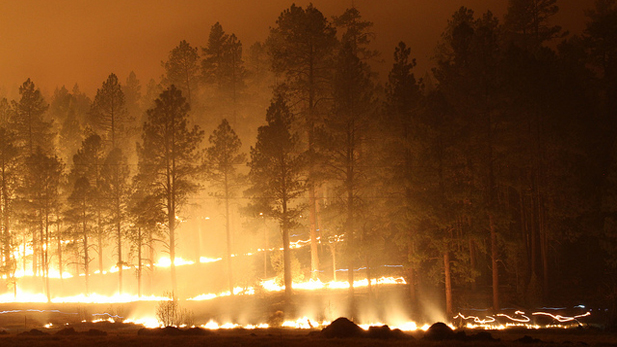 Over 3,000 firefighters battled Arizona's record-breaking Wallow Fire.
Over 3,000 firefighters battled Arizona's record-breaking Wallow Fire.The record-setting wildfires that scorched nearly 1 million acres of Arizona's forests and grasslands this summer could have been avoided had proper forest management techniques been in place, forestry and fire experts say.
That doesn't mean elimination of all wildfires, however.
"I think we have to accept that in Arizona, particularly the White Mountains, fire is inevitable," said Stephen J. Pyne, a fire historian and professor in Arizona State University's School of Life Sciences. "As long as we keep this as public land and we want to keep it in a quasi-wild state, fire is going to happen."
Pyne spoke in an interview airing on Arizona Week Friday, Aug. 26.
He and his family own a cabin in Alpine that escaped damage in the Wallow Fire, which burned for five weeks, scorching a state record 538,000 acres and destroying numerous summer homes and businesses before it was contained in July. It left large parts of the area closed off to recreation at the peak of the summer season.
In its wake, the Wallow Fire sparked criticism of environmentalists, who were accused of contributing to the conflagration by pushing for bans on cattle grazing and logging -- two activities that some said could help make the forests less susceptible to fire.
Pyne said that and other arguments over the years weren't really about fire but rather about other issues.
"People are using fire and the wonderfully graphic and telegenic qualities of fire to animate some other message," he said. "They all have their backs to the fire to speak to some other audience about some other theme."
His suggestion was that people from different constituencies turn and talk with one another.
That, in fact, has already begun via several projects aimed at strategic restoration of Arizona forest lands. The White Mountain Stewardship project and the Four Forest Restoration Initiative both aim to allow prescribed burning, some thinning through a commercial partnership that may help offset restoration costs, and other forest management practices.
"You're going to need to do a lot more prescribed burning than you are now," Pyne said in response to a question about how to reduce wildfire dangers. "Right now, instead of tame fire, we're relying on feral fire to do that ecological work."
Extensive or random logging and other commercial uses, protection at all costs from fires and other one-time or isolated tactics won't solve the problem, Pyne and others said.
Molly E. Hunter, a forestry ecologist and professor in Northern Arizona University's School of Forestry, said in an Arizona Week interview that comprehensive, strategic approaches including prescribed burning have shown early success, specifically in New Mexico.
"There've been some fires that have been in the Gila National Forest this summer, and they've been with relatively low intensity and severity ... even under these really extreme climatic conditions that we've seen this summer," Hunter said. "I think it's a good example of how we can kind of safely reintroduce fire into the landscape and see some beneficial effects."
Hunter said it's good not only for the forests but for the people who use them.
"A healthy, restored forest is often better for recreation," she said. "There've been studies that show people find these more open forests more aesthetically pleasing."
Reporter Michael Chihak explores the aftermath of Arizona's wildfires and forest restoration in the August 26 issue of Arizona Week. Click to watch:

By submitting your comments, you hereby give AZPM the right to post your comments and potentially use them in any other form of media operated by this institution.